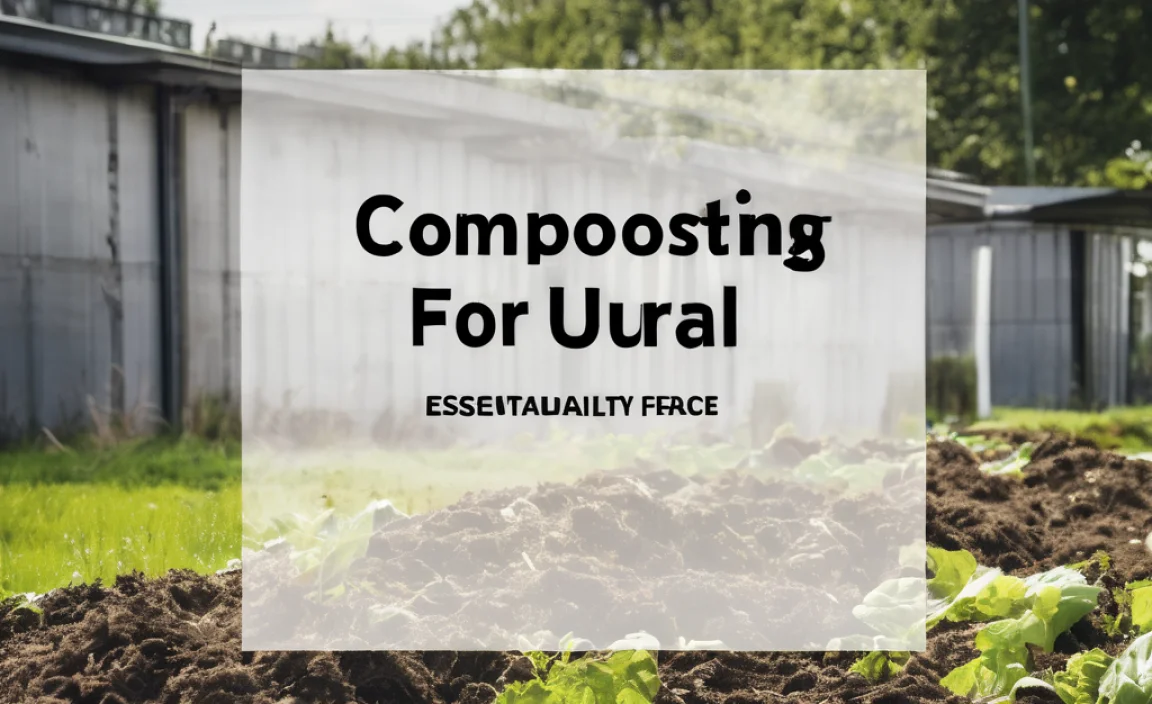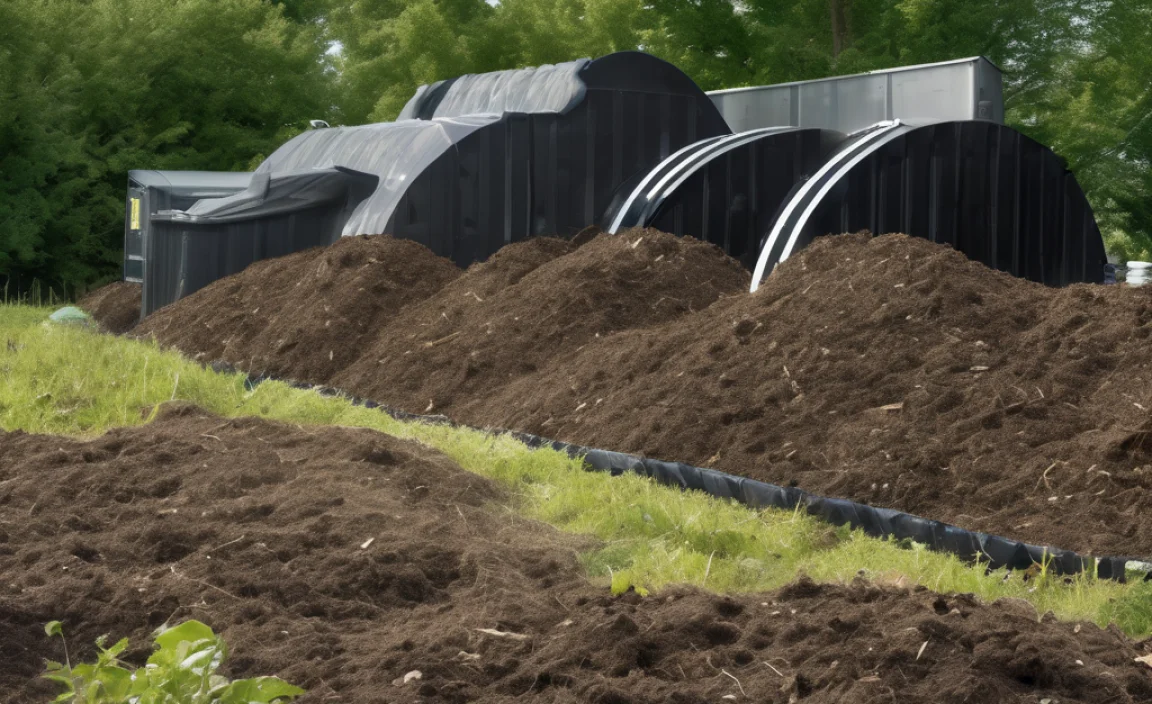Welcome to TopChooser! I’m Troy D Harn, and I’m here to make home improvement, gardening, and DIY projects easy peasy. Ever feel like your kitchen scraps are just… trash? And you wish you could do something good for your plants and the planet, but you live in an apartment and think it’s impossible? You’re not alone! Many apartment dwellers think composting is a faraway dream.
But guess what? You can totally compost right in your living space. We’re talking about vermicomposting – using worms to turn your food waste into amazing plant food. It sounds a bit wild, but I’ll walk you through every simple step. Ready to turn your scraps into garden gold?
Why Vermicompost in Your Apartment?
Living in an apartment doesn’t mean you can’t engage in eco-friendly practices. Vermicomposting, or worm composting, is a fantastic way to reduce your household waste while creating nutrient-rich fertilizer for your houseplants or balcony garden. It’s a surprisingly clean, odor-free, and efficient process that even beginners can master. Plus, it’s a great way to feel more connected to nature, right inside your home!
Benefits of Apartment Vermicomposting
- Waste Reduction: Diverts a significant amount of food scraps from landfills.
- Rich Fertilizer: Produces “worm castings,” a superior natural fertilizer for plants.
- Odor-Free: When done correctly, a worm bin doesn’t smell bad.
- Educational and Fun: A great way to learn about decomposition and the life cycle of worms.
- Space-Saving: Worm bins are compact and can fit in various apartment spaces.
- Sustainable Living: Contributes to a greener lifestyle, even without a yard.
Getting Started: Your Apartment Worm Farm Essentials
Setting up a vermicomposting system is simpler than you might think. You don’t need a lot of space or complicated equipment. We’ll break down exactly what you need to get your worm farm thriving.
Choosing Your Worm Bin
The worm bin is your worm’s home. For apartment living, size and ventilation are key. You have a few options:
- DIY Bin: This is a budget-friendly option perfect for the DIY enthusiast. You can repurpose plastic storage containers.
- Purchased Bin: Many companies sell ready-made worm composting systems designed for indoor use. These often have multiple tiers for easy harvesting.
A good starting point is a bin that’s about 1 cubic foot (around 11 x 11 x 11 inches or 28 x 28 x 28 cm) but can be adjusted based on how much food waste your household produces. Look for bins with lids that can be secured but also allow for airflow.
Essential Worm Bin Components
Regardless of whether you buy or build your bin, you’ll need these basic components:
- Container: A sturdy, opaque plastic bin works best. Opaque bins mimic natural burrows and keep light out, which worms dislike.
- Lid: A lid is crucial to keep moisture in and pests out. Ensure it allows for ventilation. You can add air holes or modify it slightly.
- Bedding: This is what the worms will live in. It needs to be absorbent and provide structure.
- Worms: You can’t compost without worms!
- Food Scraps: The worms’ diet!
For a DIY bin, a standard plastic tote with a lid is a great starting point. You’ll need to drill some holes: a few small ones in the bottom for drainage (worms need it moist, not soggy!) and some in the lid for airflow. For purchased bins, they usually come with pre-drilled holes or built-in ventilation.
What You’ll Need: A Quick Shopping List
Here’s a handy list of what you’ll need to buy or gather:
| Item | Description | Where to Find |
|---|---|---|
| Worm Bin Container | Opaque plastic tote with lid (approx. 1 cubic foot) OR a pre-made worm farm. | Hardware store, home goods store, online retailers. |
| Bedding Material | Shredded newspaper, cardboard, coconut coir, or aged leaves. | Home, office supply store, gardening center, online. |
| Composting Worms | Red wigglers (Eisenia fetida) are the best choice. | Online worm farms, bait shops, experienced composters. |
| Food Scraps | Vegetable and fruit peels, coffee grounds, tea bags, crushed eggshells. | Your kitchen! |
| Optional: Worm bin bedding block | Compressed brick that expands with water. | Gardening centers, online. |
Choosing Your Worms: The Most Important Ingredient
Not all worms are created equal when it comes to composting. You need specific types that are voracious eaters and thrive in the conditions of a worm bin. The superstar of vermicomposting is the Red Wiggler (Eisenia fetida).
Why Red Wigglers?:
- They are surface dwellers and prefer decaying organic matter, which is exactly what you’ll put in their bin.
- They reproduce quickly in optimal conditions, meaning you’ll always have enough composters.
- They are very efficient at breaking down food scraps.
You generally won’t need more than a quarter-pound (about 250 worms) to start for a small bin. You can purchase them online from reputable worm farms. Make sure they are shipped live and healthy! For more information on different composting worms, the University of New Hampshire Extension offers great resources.
Setting Up Your Worm Bin: Step-by-Step
Alright, let’s get this worm paradise ready! Setting up is pretty straightforward. Follow these steps carefully, and you’ll have a happy worm community in no time.
- Prepare Your Bin: If you’re using a DIY bin, drill your drainage holes (about 4-6 small holes in the bottom) and a few ventilation holes near the top of the sides and in the lid. If you have a purchased bin, ensure you understand how its existing ventilation and drainage work.
- Add Bedding: Moisten your bedding material (shredded newspaper, cardboard, coconut coir) so it feels like a wrung-out sponge – damp but not dripping. This is crucial for worm health. Fill about half to two-thirds of your bin with the prepared bedding. Fluff it up to create airy pathways for the worms.
- Introduce Your Worms: Gently place your composting worms on top of the bedding. Leave them for about 10-15 minutes without disturbing them. They will naturally burrow down into the bedding to escape the light.
- Add a Small Amount of Food: Bury a small portion of food scraps (see “What to Feed Your Worms” below) under the bedding. This gives them something to munch on right away.
- Close the Lid: Secure the lid to create a dark, moist environment.
- Find a Suitable Location: Place your worm bin in a location that stays between 55-75°F (13-24°C). A closet, under the sink (if temperatures are stable), or a corner of a room usually works well. Avoid direct sunlight or extreme temperatures.
Your worms will need a few days to acclimate to their new home before you start feeding them regularly. Be patient!
What to Feed Your Worms (and What NOT to Feed Them!)
Worms are amazing recyclers, but they have dietary preferences and some forbidden foods. Feeding your worms can be a bit of a balancing act to avoid odors or pests. The more varied their diet, the better the output!
Good Foods for Worms:
- Fruit and vegetable scraps (peels, cores, ends, wilted greens)
- Coffee grounds and paper filters
- Tea bags (remove any staples or plastic tags)
- Crushed eggshells (rinsed and dried)
- Bread and pasta (in moderation, and avoid oily or cheesy versions)
- Cooked and plain grains (oatmeal, rice)
- Small amounts of shredded plain paper or cardboard (excellent for bedding too!)
Foods to Avoid:
- Meat, fish, and bones: These can attract pests and cause odors.
- Dairy products: Can also lead to odors and attract pests.
- Oily or greasy foods: Can create an anaerobic environment and harm the worms.
- Citrus peels (in large quantities): While small amounts are okay, too much can make the bin too acidic.
- Spicy foods: Such as onions, garlic, and peppers.
- Processed foods: Often contain salt and preservatives that are bad for worms.
- Pet waste: Can contain pathogens, making the compost unsafe for gardening.
Tip: Chop larger food scraps into smaller pieces. This helps them break down faster, making it easier for your worms to consume.
Maintaining Your Apartment Worm Farm
Once everything is set up, worm farm maintenance is minimal, especially for beginners. The key variables to monitor are moisture, aeration, and feeding.
Moisture Levels
Your worm bin should be consistently moist, like a wrung-out sponge. If it’s too dry, add a little water. If it’s too wet, add more dry bedding material and ensure your drainage holes are clear. Worms breathe through their skin, and they need moisture to survive.
Aeration
Worms need oxygen. Ensure your ventilation holes aren’t blocked. You can gently aerate the top layer of bedding with a small garden fork or stick every week or two. Don’t dig too deep, as you might disturb the worms!
Feeding Schedule
Start by feeding your worms conservatively. Bury a small amount of food scraps under the bedding once or twice a week. You’ll learn how quickly they consume it. When they start eating the food within a few days, you can gradually increase the amount. If you notice a lot of uneaten food after a week, reduce the quantity. Overfeeding is a common beginner mistake that can lead to odors and pests.
Temperature
Keep your bin within the ideal temperature range of 55-75°F (13-24°C). If your apartment gets too warm, you might need to find a cooler spot or insulate your bin. If it gets too cold, move it to a warmer location.
Harvesting Your Worm Castings
This is the exciting part! After a few months, you’ll start accumulating worm castings, also known as “worm poop.” This is pure, black gold for your plants. Here are a few ways to harvest them:
The “Migration” Method
This is a popular method for multi-tier bins or when you’re ready to harvest from a single bin.
- Stop Feeding the Bottom: If you have a multi-tier bin, stop adding fresh food scraps to the bottom working tray.
- Start Feeding the Top: Begin adding all new food scraps and bedding to the top tray or to one side of your single bin.
- Wait for Migration: The worms, seeking fresh food and bedding, will migrate upwards into the new material. This usually takes a few weeks.
- Harvest: Once most of the worms have moved to the new area, you can remove the original tray (or the “empty” side of your bin) and harvest the finished castings.
“Light” Harvesting (for Single Bins)
If you only have a single bin, you can try this:
- Stop Feeding: Stop adding food for about a week.
- Dump and Sort: Dump the contents of your bin onto a plastic sheet or tarp in a well-lit area.
- Separate: The worms will try to escape the light by burrowing down. Use your hands or a small trowel to scrape away the top layer of castings. Continue scraping layers until you get to the concentrated worm population.
- Collect Castings: Gather the castings.
- Return Worms: Gently place the worms and any remaining unprocessed material back into your bin. Add fresh bedding and start feeding again.
Fresh worm castings are rich in nutrients that plants love. You can mix them directly into your potting soil, use them as a top dressing for houseplants, or make a “worm tea” by steeping castings in water for a liquid fertilizer.
Troubleshooting Common Worm Bin Issues
Even with the best intentions, you might encounter a hiccup or two. Here are some common problems and how to fix them.
Problem: Fruit Flies or Gnats
Cause: Exposed food scraps, overfeeding, or bins that are too wet.
Solution: Make sure all food scraps are buried under the bedding. Reduce feeding if you see a lot of flies. Add more dry bedding to absorb excess moisture. Some people use sticky traps placed near the bin (not inside) to catch them.
Problem: Unpleasant Odors
Cause: Overfeeding, anaerobic conditions (lack of air), or putting in forbidden foods.
Solution: Stop feeding for a few days. Gently aerate the bin. Add more dry bedding to absorb moisture and improve airflow. Ensure you’re only feeding your worms appropriate foods.
Problem: Worms Trying to Escape
Cause: The bin conditions are not to their liking – too wet, too dry, too acidic/alkaline, lack of food, or too much ammonia buildup.
Solution: Check your moisture levels, aeration, and food. Add more bedding if it’s too wet. Add a bit of water if it’s too dry. You can add crushed eggshells to help buffer acidity. Ensure you are not overfeeding.
Problem: Mites (Small Red or Brown)
Cause: Mites are common and often harmless, but large populations can indicate an imbalanced bin.
Solution: Ensure you’re not overfeeding and that the bin isn’t too wet. You can try adding more carbon-rich bedding like shredded cardboard. For severe infestations, you might temporarily remove the worms, wash the bin with soapy water, and start with fresh bedding, though this is rarely necessary.
Remember, worms are living creatures, and their environment needs to be just right. A happy worm bin is usually a quiet, odor-free, and productive one!
Using Your Vermicompost: Feeding Your Plants
You’ve done it! You’ve successfully transformed food scraps into nutrient-rich worm castings. Now, let’s talk about how to use this amazing fertilizer.
For Potted Plants
It’s incredibly easy to revitalize your indoor plants with worm castings. You can:
- Mix into Potting Soil: Add 10

I am passionate about home engineering. I specialize in designing, installing, and maintaining heating, ventilation, and air conditioning systems. My goal is to help people stay comfortable in their homes all year long.



